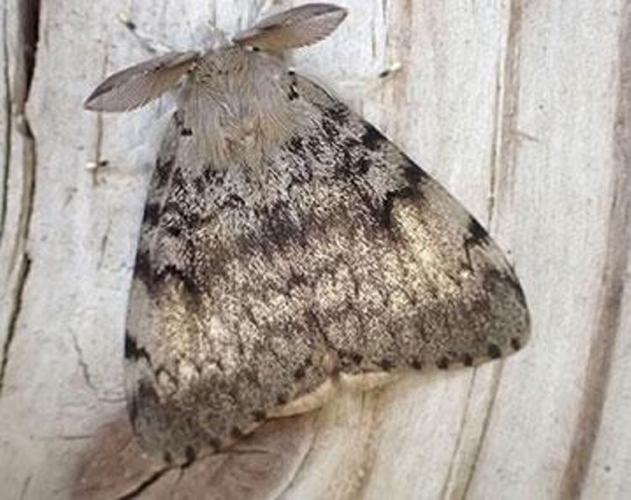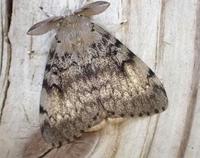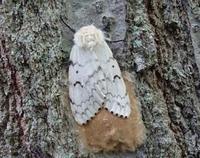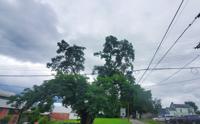Spongy moths have descended upon Columbia and Greene counties.
This type of moth is considered an invasive species notorious for its expansive diet and penchant for causing damage to plant life, particularly to shade trees. While a strong, robust and generally healthy tree can repel some defoliation, spongy moths can potentially be fatal to affected trees.
Hudson Mayor Kamal Johnson said the city is constant communication with the New York State Department of Environmental Conversation as they try to share information as it comes in.
“It’s not much the city can do on its own because this is a statewide issue. We are sharing all info from the department of conversation,” Johnson said.
Mayoral Aide Michael Hofmann isn’t concerned about the long-term environmental impact of the invasive species.
“I have definitely noticed them at home,” Hofmann said. “I’m not concerned about them in terms of long-term impact. While they’re an invasive species and damages trees there’s not a huge concern from the state perspective as far as long-term defoliation is concerned. The trees in the area will bounce back from whatever damage comes their way.”
Any damage to trees hasn’t been noticeable but the city doesn’t plan to take immediate action due to advice from the state.
“Visually we haven’t noticed any damage, the city won’t be taking any action,” Hofmann said. “It’s not recommended by the state to really do much to manage these outbreaks so the city won’t be taking action, but we do have information on our website for those who need it.”
Residents of Columbia County are annoyed at this moth invasion.
Justin Davis of Hudson was eating lunch at Nolita on Warren Street.
“They’re everywhere, they make me itch just thinking about it,” Davis said. “Whatever I can do to limit these pests I’m doing it. I don’t leave doors or windows open at my house. If doing little things to limit these pests can make my life easier, then that’s what I’m going to do.”
James Lagaria of Hudson thinks the moth outbreak is due to the weather.
“I feel this is one of the things that come with hot and wet weather that we’ve been experiencing for the last month,” Lagaria said. “I’m not a fortune teller but I think these moths are here for the foreseeable future, at least through the rest of the summer.”
Marvin Santiago of Hudson said the outbreak is a pressing issue, but more important affairs in the area need to be addressed.
“What can we do?” Santiago said. “The moths are an inconvenience, but they’re other pressing issues in the world that need to be addressed. Yes the moths need to be spoken about, but I feel there are more pressing issues in the area.”
According to the DEC, adult female spongy moths are white with brown markings that feature an inverted V pointing toward the head. Males are brown with black markings and have a wingspan of 1 inch to 1 1/4 inches. Adult females most commonly lay eggs on trees; but some can be found on the side of buildings, signs, trailers and other outdoor surfaces.
The eggs are dark brown clumps protected by a fuzzy, light-colored covering. If contact with these moths is made, the DEC recommends wearing gloves because contact with skin can cause itchy red rashes. The DEC also encourages people to practice proper hygiene by cleaning shoes, tools and vehicles after visiting infected areas.
According to the DEC, an outbreak can occur every 10 to 15 years in New York, and thousands of acres of trees can be damaged. Although spongy moths do not pose a major threat to New York’s forests, they are not native, and their populations can reach high, destructive levels.
Spongy moth caterpillars eat young, tender leaves in the spring. Deciduous trees — trees that lose their leaves each fall — can regrow new leaves by July and can usually withstand two to three successive years of defoliation without being killed. But defoliation reduces the vigor and resistance of the tree, and it becomes more susceptible to pests and diseases. Tree death can occur when other stresses, such as disease or other insect outbreaks, attack trees in the same year. When populations of spongy moths are very high, or when oaks and other preferred trees are limited, they will even eat evergreen species, including pine, spruce and hemlock.
“I’ve seen tons of them. Hundreds. Down at that river down there, the playground, the boat launch,” said Catskill resident Mark Laraway. “They don’t harm humans, I’m not afraid of them. I saw them three days ago, flying all over the place.”
Catskill Marina Boat Owner Bill Soulier confirmed Laraway’s comment.
“The last few days there have been quite a few moths around,” Soulier said. “I noticed them around our boat. They seem to be flying around the boats. I haven’t seen them up in the yard. It’s just one of those things that happens every year, the pollen from the trees falls sometimes, and the moths come sometimes.”
Cairo resident Michael Sandberg said he’s been lucky, not having seen the moths yet.
“We’re not having any issues with moths, to be honest,” Sandberg said. “If I look around maybe, I’ll see them on the street, but I can’t say I did.”
In terms of treatment, Greene County will not be stepping in to spray insecticide or implement other preventative measures, said Highway Superintendent Scott Templeton. The Department of Environmental Conservation handles those matters, he added.
“They’re pretty much everywhere around your homes, at the office here, they’re definitely noticeable,” said Templeton. “I’ve seen them in the woods, I’ve seen them outside the house. They haven’t come inside my house, because we’re aware of it and keeping everything closed up. But spraying and control would be handled by the New York Department of Environmental Conservation.”
A statement from the Cornell Cooperative Extension of Columbia and Greene Counties said that, as the species is so destructive to trees, homeowners might want to prevent further proliferation by using the “Crush and Brush” method, which involves brushing the moths into a container or bucket of soapy water.
Department of Environmental Conservation public information officer Lori Severino said the Department is seeing patchy defoliation throughout the lower Hudson Valley and that later this month the Department will conduct aerial surveys to better map the damage.
According to a statement from the department, the DEC will not be spraying insecticides due to the harmful effects on a variety of beneficial, native insects, as well as nesting birds and other wildlife.
Dormant oils applied to the species or the species’ eggs would be an effective means of suffocation.
One possible reason for the onslaught of spongy moths this year is that the species’ larvae thrived this spring, due to slightly drier weather. According to a fact sheet on Spongy Moths posted by the University of New Hampshire, a wet spring is detrimental to larvae.
This spring we had less rain than usual, said Abigail Gant, a meteorologist with the National Weather Service in Albany.
“In the month of June we had observed a precipitation value of 3.06 inches,” said Gant. “The norm is typically 4.05 inches. That means we’re a bit drier than usual.”















